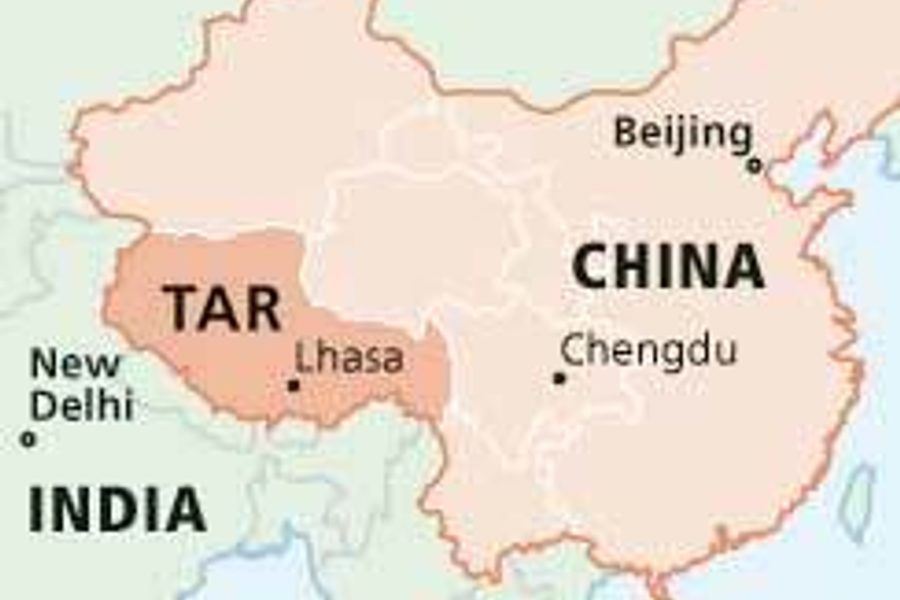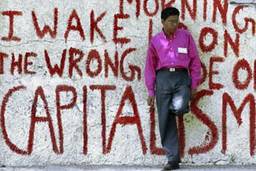
They had waited for him since dawn, sun-drenched along an uneven mountain road. But when the Dalai Lama’s motorcade swept by, his passing wave left many vaguely disenchanted.
Officials had warned that he would not be stopping; nevertheless, disappointment is hard to accept from a man many consider a god.
Now, as the 68-year-old Dalai Lama engages in talks with the Chinese government on the future of Tibet, there is a deepening sense of foreboding that he is falling short.
Last September, after intense secret negotiations, a personal emissary of the Dalai Lama met with the Chinese government in Beijing for the first time since 1959. A second meeting followed in May this year.
Many of Tibet’s 110,000 exiles see this as progress toward their return home. But others are irked by how much the Dalai Lama has conceded just to get a seat at the table.
His Holiness, as the Dalai Lama is universally called here, has dropped Tibet’s demand for independence from China in return for autonomy. There are also indications that Tibetans might accept this autonomy over a limited part of Tibet.
Long before Communist China’s army entered Tibet in the early 1950s, vast tracts of Tibetan land had been absorbed by China into regions such as Qinghai, Sichuan, Gansu and Yunnan. In 1959, when the Dalai Lama fled to India, China gained control over what was left of Tibet and in 1965 turned this area into a province called the Tibet Autonomous Region (TAR).
The Dalai Lama now lays claim to all traditional Tibetan land, both TAR and the areas seized by China. But many say this demand is unrealistic and he should be flexible.
But not everyone is happy with the concessions being made to the Chinese.
“You cannot give up the independence of Tibet. Anyone who tries this is making a mistake,” says Kalsang Godrupka Phuntsok, president of the Tibetan Youth Congress (TYC). With 20,000 members, the TYC is the largest NGO within the Tibetan community and is critical of the Dalai Lama’s “middle path” diplomacy.
Sitting in the TYC’s spartan headquarters, Phuntsok says: “The negotiations mean nothing. The Chinese cannot be trusted. They are just playing with (the Dalai Lama), buying time and waiting for him to die.”
Phuntsok says the time has come for Tibetans to set aside nonviolence and begin “targeted, victimless violence” against the Chinese, such as blowing up economic targets and railway bridges.
Students around him nod and say they are willing to die for their cause. Dhondup Dorjee, 24, explains why. “It’s not that I believe in violence,” he says sharply, “but even a street dog, if he’s cornered, will bite you.”
With the Tibetan struggle iconized by the smiling, benevolent face of the Dalai Lama, such sentiments may surprise some. Few people realize that the Tibetans have tried violence against the Chinese before. Between the mid-’50s and 1972, Tibetans waged a covert war against China from Mustang in Nepal with the assistance of the U.S. Central Intelligence Agency.
The operation, code-named ST CIRCUS, was one of the CIA’s longest-running projects.
Thousands of Tibetan guerillas were trained at a base called Dhumra, or “the garden,” at Camp Hale in Colorado and also in Saipan. They were then parachuted into Tibet via Thailand or were smuggled in over land from Nepal.
President Nixon ended ST CIRCUS when he re-established diplomatic ties with China, and the operation’s records have never been made public.
Lhasang Tsering, 52, an ex-president of TYC, was a young participant in ST CIRCUS in its dying days. He says it is time to reopen that chapter because the “very survival of Tibet is threatened. The single biggest factor,” he says, “is China’s policy of population transfer into Tibet.”
China is swamping Tibet with Han Chinese in an attempt to integrate it into the mainland. To Tibetans this is the most potent threat China has hurled at their existence—more than the million who have died from Chinese policies, the destruction of more than 6,000 Buddhist monasteries, the arrest and torture of Tibetan monks, the denuding of Tibetan forests, and the stationing of nuclear weapons and waste dumps in Tibet.
Samdhong Rinpoche, 64, is a monk and prime minister of the Tibetan government-in-exile. He estimates that 7 million Han Chinese now live in Tibet, almost a hundred times the number claimed by China. There are only 2.3 million Tibetans.
“In towns like Lhasa and Chengdu, 75 percent of the people are Han Chinese,” says Rinpoche. “[Soon] we may become just like the Mongolians. Our culture and heritage will be completely lost.”
Tsering points to the building of a railroad into Tibet that will be used to flood the region with Han Chinese even as the Chinese are talking with the Dalai Lama as proof that negotiations will fail.
Rinpoche agrees that continuing Han migration will devastate Tibet, but he says that violence could destroy Tibetan culture just as certainly.
“Our main goal is to preserve our spiritual and cultural traditions, and nonviolence is part of that. If we give up on this then we cannot say we are preserving Tibetan culture,” he says.
Such high-mindedness is lost on Phuntsok. While professing deep respect for the spiritual leadership of the Dalai Lama and monks such as Rinpoche, Phuntsok says their moral convictions make them unsuitable political leaders.
“I want to ask the Dalai Lama: ‘If you could achieve Tibetan independence in a day by killing 100 Chinese would you do it?’ If he says no, he cannot be the leader of the Tibetan people. He values his philosophies more. Monks are good people but perhaps too good for the raw politics consuming us,” he says.
Tibetans know they are being played as pawns. In his book Freedom in Exile, the Dalai Lama writes that the CIA supported ST CIRCUS “not because they cared about Tibetan independence, but as part of their worldwide efforts to destabilize all Communist governments.”
Recently India, too, has forsaken the Tibetans to pursue its own interests. Though India remains a safe harbor for Tibetan refugees, most of whom live in the southern Indian state of Karnataka, and hosts the Tibetan government-in-exile in Dharamsala, New Delhi has been distancing itself from the Tibetan struggle as it builds closer ties with Beijing.
When Indian Prime Minister Atal Vajpayee visited China this June he dropped the earlier Indian stance that maintained “Tibet as an autonomous region of China.” Instead Vajpayee declared, “the Tibet Autonomous Region is part of the territory of People’s Republic of China.”
By accepting China’s limited definition of Tibet and by saying TAR was Chinese territory and not an autonomous region, India was, in effect, accepting China’s key positions on the issue.
The next day the Chinese gave de facto recognition to India’s sovereignty over the disputed Himalayan state of Sikkim, which India annexed in 1975.
Looking past Dharamsala’s main street crowded with tourists eager to taste Tibetan mystic and the stores crammed with prayer beads and holy books that service them, Tsering says the struggle has never been lonelier.
“I told His Holiness,” Tsering says, “I told him 25 years ago. Stop waiting for the world to save us. Stop hoping the Chinese will change. Whether the cat is white or black, it is going to eat the mouse. To get our freedom we must fight, maybe die. That is our only chance.”
Tsering and Phuntsok acknowledge an insurgency against China has little chance of success. But pointing to East Timor they say an insurgency could take advantage of internal discord in China if and when it surfaces.
“Jose Ramos-Horta (the current foreign minister of East Timor) and I used to work together in Geneva,” says Tsering. “He took it for granted that we would be free before them, but then Indonesia collapsed and they took the opportunity. Today China is a very unstable country. If it crumbles we must be ready to seize the opportunity.”
The TYC has little knowledge and fewer means to act on its ideas. Yet it remains a wild card in an increasingly complicated web of power politics. Phuntsok himself throws open the question as to whether the TYC is a stick the Dalai Lama uses to contrast with his own carrot. If so, the message the Dalai Lama wants to send the Chinese is clear—if you don’t deal with reasonable me before I die, you might be left having to deal with these young turks.
Officials had warned that he would not be stopping; nevertheless, disappointment is hard to accept from a man many consider a god.
Now, as the 68-year-old Dalai Lama engages in talks with the Chinese government on the future of Tibet, there is a deepening sense of foreboding that he is falling short.
Last September, after intense secret negotiations, a personal emissary of the Dalai Lama met with the Chinese government in Beijing for the first time since 1959. A second meeting followed in May this year.
Many of Tibet’s 110,000 exiles see this as progress toward their return home. But others are irked by how much the Dalai Lama has conceded just to get a seat at the table.
His Holiness, as the Dalai Lama is universally called here, has dropped Tibet’s demand for independence from China in return for autonomy. There are also indications that Tibetans might accept this autonomy over a limited part of Tibet.
Long before Communist China’s army entered Tibet in the early 1950s, vast tracts of Tibetan land had been absorbed by China into regions such as Qinghai, Sichuan, Gansu and Yunnan. In 1959, when the Dalai Lama fled to India, China gained control over what was left of Tibet and in 1965 turned this area into a province called the Tibet Autonomous Region (TAR).
The Dalai Lama now lays claim to all traditional Tibetan land, both TAR and the areas seized by China. But many say this demand is unrealistic and he should be flexible.
A Cornered Dog May Bite
But not everyone is happy with the concessions being made to the Chinese.
“You cannot give up the independence of Tibet. Anyone who tries this is making a mistake,” says Kalsang Godrupka Phuntsok, president of the Tibetan Youth Congress (TYC). With 20,000 members, the TYC is the largest NGO within the Tibetan community and is critical of the Dalai Lama’s “middle path” diplomacy.
Sitting in the TYC’s spartan headquarters, Phuntsok says: “The negotiations mean nothing. The Chinese cannot be trusted. They are just playing with (the Dalai Lama), buying time and waiting for him to die.”
Phuntsok says the time has come for Tibetans to set aside nonviolence and begin “targeted, victimless violence” against the Chinese, such as blowing up economic targets and railway bridges.
Students around him nod and say they are willing to die for their cause. Dhondup Dorjee, 24, explains why. “It’s not that I believe in violence,” he says sharply, “but even a street dog, if he’s cornered, will bite you.”
Not Always Nonviolent
With the Tibetan struggle iconized by the smiling, benevolent face of the Dalai Lama, such sentiments may surprise some. Few people realize that the Tibetans have tried violence against the Chinese before. Between the mid-’50s and 1972, Tibetans waged a covert war against China from Mustang in Nepal with the assistance of the U.S. Central Intelligence Agency.
The operation, code-named ST CIRCUS, was one of the CIA’s longest-running projects.
Thousands of Tibetan guerillas were trained at a base called Dhumra, or “the garden,” at Camp Hale in Colorado and also in Saipan. They were then parachuted into Tibet via Thailand or were smuggled in over land from Nepal.
President Nixon ended ST CIRCUS when he re-established diplomatic ties with China, and the operation’s records have never been made public.
Lhasang Tsering, 52, an ex-president of TYC, was a young participant in ST CIRCUS in its dying days. He says it is time to reopen that chapter because the “very survival of Tibet is threatened. The single biggest factor,” he says, “is China’s policy of population transfer into Tibet.”
A Culture Overwhelmed
China is swamping Tibet with Han Chinese in an attempt to integrate it into the mainland. To Tibetans this is the most potent threat China has hurled at their existence—more than the million who have died from Chinese policies, the destruction of more than 6,000 Buddhist monasteries, the arrest and torture of Tibetan monks, the denuding of Tibetan forests, and the stationing of nuclear weapons and waste dumps in Tibet.
Samdhong Rinpoche, 64, is a monk and prime minister of the Tibetan government-in-exile. He estimates that 7 million Han Chinese now live in Tibet, almost a hundred times the number claimed by China. There are only 2.3 million Tibetans.
“In towns like Lhasa and Chengdu, 75 percent of the people are Han Chinese,” says Rinpoche. “[Soon] we may become just like the Mongolians. Our culture and heritage will be completely lost.”
Tsering points to the building of a railroad into Tibet that will be used to flood the region with Han Chinese even as the Chinese are talking with the Dalai Lama as proof that negotiations will fail.
Rinpoche agrees that continuing Han migration will devastate Tibet, but he says that violence could destroy Tibetan culture just as certainly.
“Our main goal is to preserve our spiritual and cultural traditions, and nonviolence is part of that. If we give up on this then we cannot say we are preserving Tibetan culture,” he says.
Such high-mindedness is lost on Phuntsok. While professing deep respect for the spiritual leadership of the Dalai Lama and monks such as Rinpoche, Phuntsok says their moral convictions make them unsuitable political leaders.
“I want to ask the Dalai Lama: ‘If you could achieve Tibetan independence in a day by killing 100 Chinese would you do it?’ If he says no, he cannot be the leader of the Tibetan people. He values his philosophies more. Monks are good people but perhaps too good for the raw politics consuming us,” he says.
Tibetans know they are being played as pawns. In his book Freedom in Exile, the Dalai Lama writes that the CIA supported ST CIRCUS “not because they cared about Tibetan independence, but as part of their worldwide efforts to destabilize all Communist governments.”
India Backs Away
Recently India, too, has forsaken the Tibetans to pursue its own interests. Though India remains a safe harbor for Tibetan refugees, most of whom live in the southern Indian state of Karnataka, and hosts the Tibetan government-in-exile in Dharamsala, New Delhi has been distancing itself from the Tibetan struggle as it builds closer ties with Beijing.
When Indian Prime Minister Atal Vajpayee visited China this June he dropped the earlier Indian stance that maintained “Tibet as an autonomous region of China.” Instead Vajpayee declared, “the Tibet Autonomous Region is part of the territory of People’s Republic of China.”
By accepting China’s limited definition of Tibet and by saying TAR was Chinese territory and not an autonomous region, India was, in effect, accepting China’s key positions on the issue.
The next day the Chinese gave de facto recognition to India’s sovereignty over the disputed Himalayan state of Sikkim, which India annexed in 1975.
A Cat and Mouse Game?
Looking past Dharamsala’s main street crowded with tourists eager to taste Tibetan mystic and the stores crammed with prayer beads and holy books that service them, Tsering says the struggle has never been lonelier.
“I told His Holiness,” Tsering says, “I told him 25 years ago. Stop waiting for the world to save us. Stop hoping the Chinese will change. Whether the cat is white or black, it is going to eat the mouse. To get our freedom we must fight, maybe die. That is our only chance.”
Tsering and Phuntsok acknowledge an insurgency against China has little chance of success. But pointing to East Timor they say an insurgency could take advantage of internal discord in China if and when it surfaces.
“Jose Ramos-Horta (the current foreign minister of East Timor) and I used to work together in Geneva,” says Tsering. “He took it for granted that we would be free before them, but then Indonesia collapsed and they took the opportunity. Today China is a very unstable country. If it crumbles we must be ready to seize the opportunity.”
The TYC has little knowledge and fewer means to act on its ideas. Yet it remains a wild card in an increasingly complicated web of power politics. Phuntsok himself throws open the question as to whether the TYC is a stick the Dalai Lama uses to contrast with his own carrot. If so, the message the Dalai Lama wants to send the Chinese is clear—if you don’t deal with reasonable me before I die, you might be left having to deal with these young turks.
Please consider supporting our work.

I hope you found this article important. Before you leave, I want to ask you to consider supporting our work with a donation. In These Times needs readers like you to help sustain our mission. We don’t depend on—or want—corporate advertising or deep-pocketed billionaires to fund our journalism. We’re supported by you, the reader, so we can focus on covering the issues that matter most to the progressive movement without fear or compromise.
Our work isn’t hidden behind a paywall because of people like you who support our journalism. We want to keep it that way. If you value the work we do and the movements we cover, please consider donating to In These Times.
Jehangir Pocha is the Asia correspondent for In These Times.






